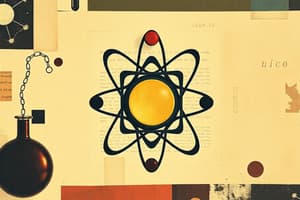Podcast
Questions and Answers
What is the smallest unit of matter?
What is the smallest unit of matter?
- Neutron
- Electron
- Atom (correct)
- Proton
What part of an atom determines the element's identity?
What part of an atom determines the element's identity?
- Neutron
- Proton (correct)
- Electron
- Valence shell
Which subatomic particle carries a positive charge?
Which subatomic particle carries a positive charge?
- Electron
- Proton (correct)
- Neutron
- Valence electron
What role does the outermost shell of an atom play in chemical bonding?
What role does the outermost shell of an atom play in chemical bonding?
Which classification comprises only one type of atom?
Which classification comprises only one type of atom?
What are the basic building blocks of all matter?
What are the basic building blocks of all matter?
What is the defining characteristic of compounds?
What is the defining characteristic of compounds?
Which example best illustrates a compound?
Which example best illustrates a compound?
How does understanding the atomic structure of matter benefit us in daily life?
How does understanding the atomic structure of matter benefit us in daily life?
Why is chemistry important in understanding nutrition?
Why is chemistry important in understanding nutrition?
What role does chemistry play in developing new medications?
What role does chemistry play in developing new medications?
How does chemistry help in protecting the environment?
How does chemistry help in protecting the environment?
Flashcards are hidden until you start studying
Study Notes
Exploring the World of Chemistry: Atomic Structure and Surroundings
Chemistry is a scientific discipline that investigates the composition, properties, and interactions of matter. To delve into this fascinating world, let's first unravel the fundamental concept of atomic structure and then examine the matter we encounter daily in our surroundings.
Atomic Structure
The smallest unit of matter is the atom. Each atom consists of a tiny, dense nucleus surrounded by electrons orbiting in distinct energy levels. The nucleus, in turn, is composed of protons, which carry a positive charge, and neutrons, which are electrically neutral. The number of protons in the nucleus determines the element's identity.
The electrons, which possess a negative charge, orbit the nucleus in specific energy levels or shells. The outermost shell, also known as the valence shell, plays a crucial role in chemical bonding and interaction between atoms.
Atomic structure is a critical aspect of chemistry because it provides a framework for understanding the behavior of atoms and molecules, which is essential for explaining and predicting chemical reactions.
Matter in Our Surroundings
The world around us is composed of various substances, each with unique and specific properties. These substances can be classified as either elements or compounds.
-
Elements: Comprising only one type of atom, elements are the basic building blocks of all matter. They cannot be broken down into simpler substances by chemical means. The Periodic Table lists all known elements, each with its own symbol and atomic number.
-
Compounds: Made from two or more elements chemically combined in a specific ratio, compounds possess unique properties that differ from those of their constituent elements. For instance, water (H₂O) is a compound formed from hydrogen and oxygen atoms, while table salt (NaCl) is a compound of sodium and chlorine.
By understanding the atomic structure of elements and compounds, we can gain a deeper appreciation for the complex interactions between matter and the fundamental principles that govern these interactions.
Everyday Applications
Understanding chemistry is not just about learning abstract concepts; it also applies to our daily lives. By examining the atomic structure of matter, we can better understand the characteristics and behavior of everyday substances, such as:
-
Food: Chemistry is integral to understanding nutrition and the role of various chemicals in our food. For example, the chemical composition of foods like vitamins, sugars, and proteins helps us understand their health benefits, as well as how they interact with our bodies.
-
Medicine: Chemistry plays a crucial role in the discovery, development, and production of medications. By understanding the molecular mechanisms of drugs, scientists can develop new treatments and cures for various diseases.
-
Environment: Chemistry helps us understand the composition of our air, water, and soil, as well as the impacts of human activities on the environment. By examining the chemical properties of pollutants, scientists can develop strategies to mitigate their effects and protect our planet.
In conclusion, chemistry is a fascinating discipline that touches almost every aspect of our lives. By understanding the fundamental concepts of atomic structure and the composition of matter in our surroundings, we can gain a deeper appreciation for the world around us and the chemical processes that shape our world. As we continue to explore and understand chemistry, we open new doors to discovery, innovation, and application that will benefit all humanity.
Studying That Suits You
Use AI to generate personalized quizzes and flashcards to suit your learning preferences.



